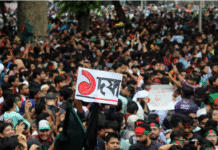The rescuers discovered her by a faint, distant sound. They had spent four days crawling through the wreckage of Rana Plaza, tons of concrete and steel pressing down, saving hundreds of people. Now only the dead remained. Except for a lone woman, a garment worker.
She was trapped behind a fallen pillar, in a suffocating crevice maybe two feet high. First, the rescuers could see only her fingertips pressing through a tiny opening. After hours spent chipping a small hole, they could see her face. Her name was Shaheena. She was 32. She begged to see her young son.
The story of Shaheena, involving a heroic if ultimately doomed rescue operation, offered the last bit of hope of finding anyone alive in what is now considered the deadliest accident in the history of the garment industry. For hours on April 28, as television reporters broadcast updates, rescuing Shaheena became a national priority. She would be trapped for more than 100 hours.
Her plight attracted so much attention because of the horror of the building collapse, with a death toll that by Sunday had exceeded 600; the drama of the long rescue effort; and the human desire to find a sliver of redemption in the tragedy. But the attention was also an anomaly: there are easily more than 2.5 million women working in the garment industry in Bangladesh whose lives usually attract scant notice, even though they are the workhorses of the national economy.
For women like Shaheena, the garment industry has been a source of empowerment as well as exploitation. Before, few rural women worked outside the fields in Bangladesh, a predominantly Muslim nation. Many, like Shaheena, are still not given a surname at birth. Now the industry has given many women a first step out of rural distress, with some becoming outspoken labor leaders or managers in their factories.
But more often, a factory job has meant a daily struggle to subsist on low wages consumed by rising rents and living expenses. The day before Rana Plaza collapsed on April 24, the five factories inside the building were temporarily closed when cracks were discovered in the structure. But relatives say Shaheena insisted on returning to work at her factory, Phantom Tec, even as her brother-in-law warned that the building might be unsafe.
“If I don’t go to work tomorrow, I’ll be absent, and I will not get paid for the day,” Shaheena said that afternoon, according to her sister, Jesmine Akhtar. “They may delay my month’s wages. I need to pay the rent. I need to buy milk for my son.”
Her immediate concern was $25. She and her son had lived with her sister’s family in an area called Mojidpur. They were seven people sharing two small rooms with a monthly rent of $56. Even that was too much, so the families found a place for $38 a month. Everyone had moved except Shaheena; she still needed to find $25 for her share of the advance.
Her family said that her job had given Shaheena a sense of independence. She gave herself a surname, the same as her sister’s. She left her husband when she was three months pregnant with her son, Robin, because, her family said, he mistreated her. Yet that meant that she was now the only breadwinner, despite earning barely $100 a month after a decade working in factories.
“There were so many nights she worked even until midnight,” her sister recalled. “She needed money.”
The morning shift had barely started inside Rana Plaza on April 24 when the building buckled. A day earlier, an engineer had examined the cracks and warned that the building should stay closed, but the building’s owner, Sohel Rana, and the factory bosses opened that morning, anyway. Then entire factory floors collapsed, raining down concrete beams. Some people died instantly. Others would lose hands or legs to amputation during their rescue or afterward. And hundreds of others were trapped alive, desperate for water in choking, triple-digit temperatures, and desperate to be saved.
Khandoker A. Jalil, a senior station officer with the Bangladesh Fire Service, led one rescue team. To reach survivors, rescue crews cut holes in the fallen rooftop and began climbing down into the wreckage, establishing tunnels and slithering through tiny crawl spaces created by huge rolls of fabric that had blocked the collapsing beams.
Late on April 26, the third day of searching, Officer Jalil’s team discovered 13 survivors, as well as some haunting sounds. “We heard some people from the other side,” he recalled.
For more than a day, they would search for those voices, sliding through narrow passages, cutting holes to lower floors. Finally, they reached a crawl space barely 18 inches high, and the sound of the voices was sharper.
“I asked, How many of you are there?” recalled Abu Yusef, one of the firefighters. A woman answered: “There are four of us.”
Another firefighter, Abdur Rob, shined his flashlight beneath small openings under the beam. Do you see a light? he asked. No, came the answer. Here? No. And then, finally, yes. They slipped a wire through the small crack below. Shaheena pulled back.
It was now early in the afternoon of April 27. Outside, officials were readying heavy machinery to clear debris and reach the rest of the bodies. But then word went to the rooftop: the last survivors had been found.
Shaheena’s family had searched for her since the building had collapsed but found nothing for four days. Then neighbors heard something on television and contacted the family.
“We heard that the rescuers were trying to save her,” said her father, Abdul Motaleb Golder, 72. “They said Shaheena wants to survive.”
Eventually, the three other trapped women would fall silent. But as rescuers worked for more than 20 hours, Shaheena kept talking. “Her concern was that during the last four days she couldn’t hold her baby,” said Lt. Ashraful Alam Anik, one of the commandos involved in the rescue operation. “She wanted to see her child.”
Robin, who is now 20 months old, spent most of his time with his aunt, since his mother worked such long hours. On the night Robin was born, Shaheena worked until hours before giving birth and then returned to the sewing line two months later.
Shifts of rescuers changed, twice. The same firefighters who discovered her returned on April 28 to try to finish digging her out. The fallen pillar was embedded with iron rods, or rebar, that were difficult to cut in such a cramped space. So the rescuers decided to chip away at the bottom of the pillar, below the rods, and then try to cut a gap in the floor below.
They pushed an oxygen tube through the opening, and used another tube to give her saline, glucose and juice. When the hole expanded, they gave her hard biscuits. When the heat became oppressive, they cooled her with bursts from a high-pressure hose. At one point, she took a saw and hammer and began working, too, lying on her back, barely able to maneuver.
Finally, by the evening of April 28, the hole was nearly big enough. Shaheena could slide her head through, rescuers said, but not her shoulders and chest. Only a few rods in the flooring needed to be cut to make room, a job that might take an hour. Outside, thousands of people had gathered at the site as television reporters relayed the progress.
“The whole nation was looking for that lady,” said Maj. Mostafa Arif, an army officer involved in the operation.
Inside the wreckage, a civil engineer who had joined the rescue team thought he could cut through the final iron rods with a small electric grinder. A mistake. In the narrow crawl space, sparks splattered against the rolls of fabric and the shirts strewn on the floor. Fire.
“The tunnel is dark,” recalled Capt. Mahmudul Hasan, another army officer at the scene. “But suddenly we saw light coming at us.”
The rescuers scrambled up to the roof, some fainting from the smoke. The civil engineer suffered severe burns and has since died. When the rescuers later recovered her body, Shaheena was not burned; presumably she died from smoke inhalation.
“We were so upset,” said Abdur Rob, the firefighter. “We had only 1 percent of the work to finish. But at the end, everything was ruined. We broke into tears.”
Over the weekend, as work crews continued pulling out bodies, Jesmine Akhtar held tightly to her sister’s only child. He is wide-eyed and giggling and does not yet know that his mother is dead. “I will take care of Robin,” his aunt declared. “I had three children. Now I have four. He will be with me the rest of my life.”
Source: NYTimes











If Hasina allowed the international team of rescuers to save the people still alive, many like Shehena could have chance to seen the now orphans like Robin’s. Unfortunately Hasina is a strong-minded dictator, the daughter of the fascist Mujib who killed over 35 thousand and about half a million parished for a man-made famine came from his bad goverance.This was within a time of less than 4 years. Too bad people forget to learn from history and history repeats itself.